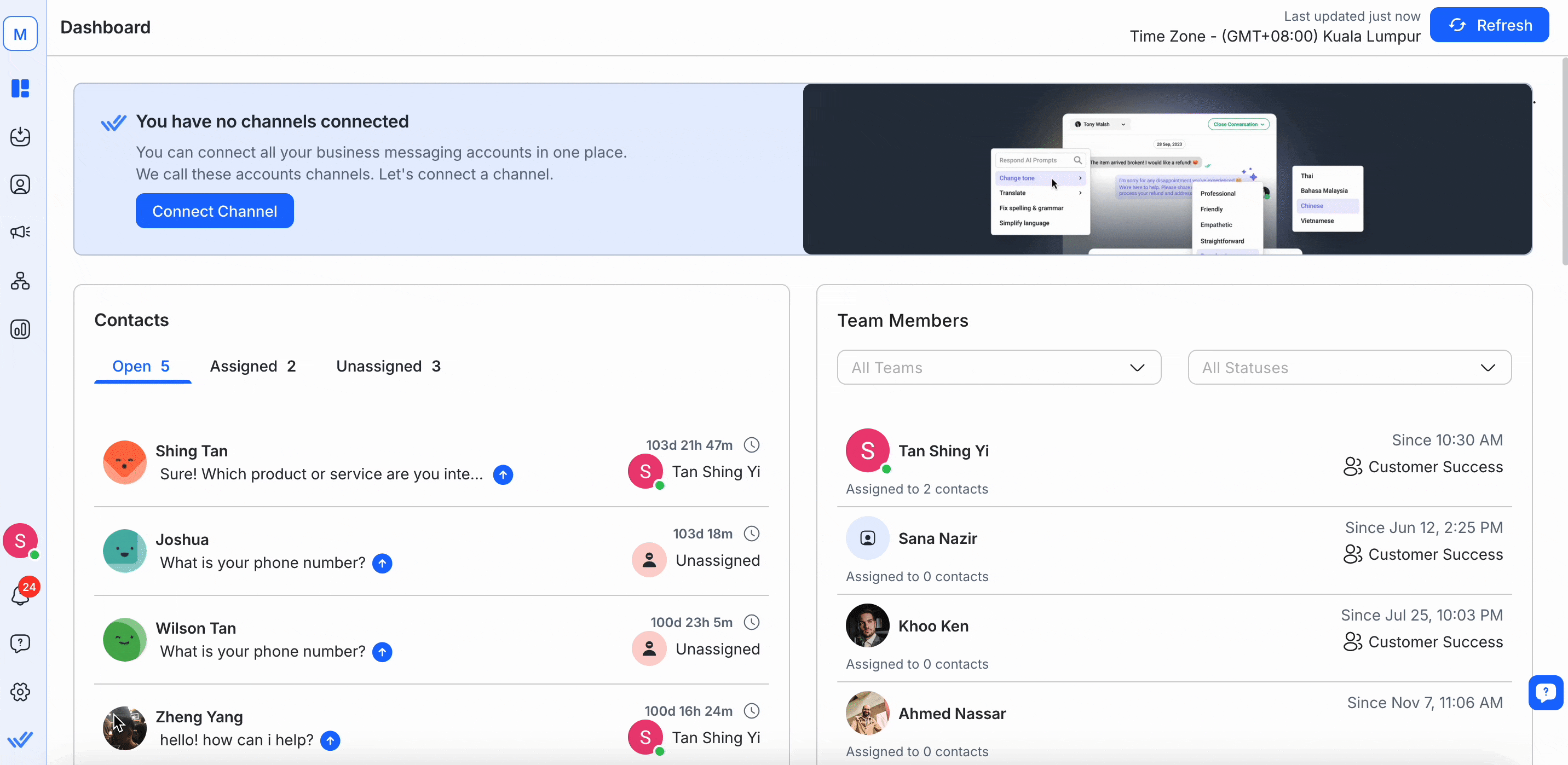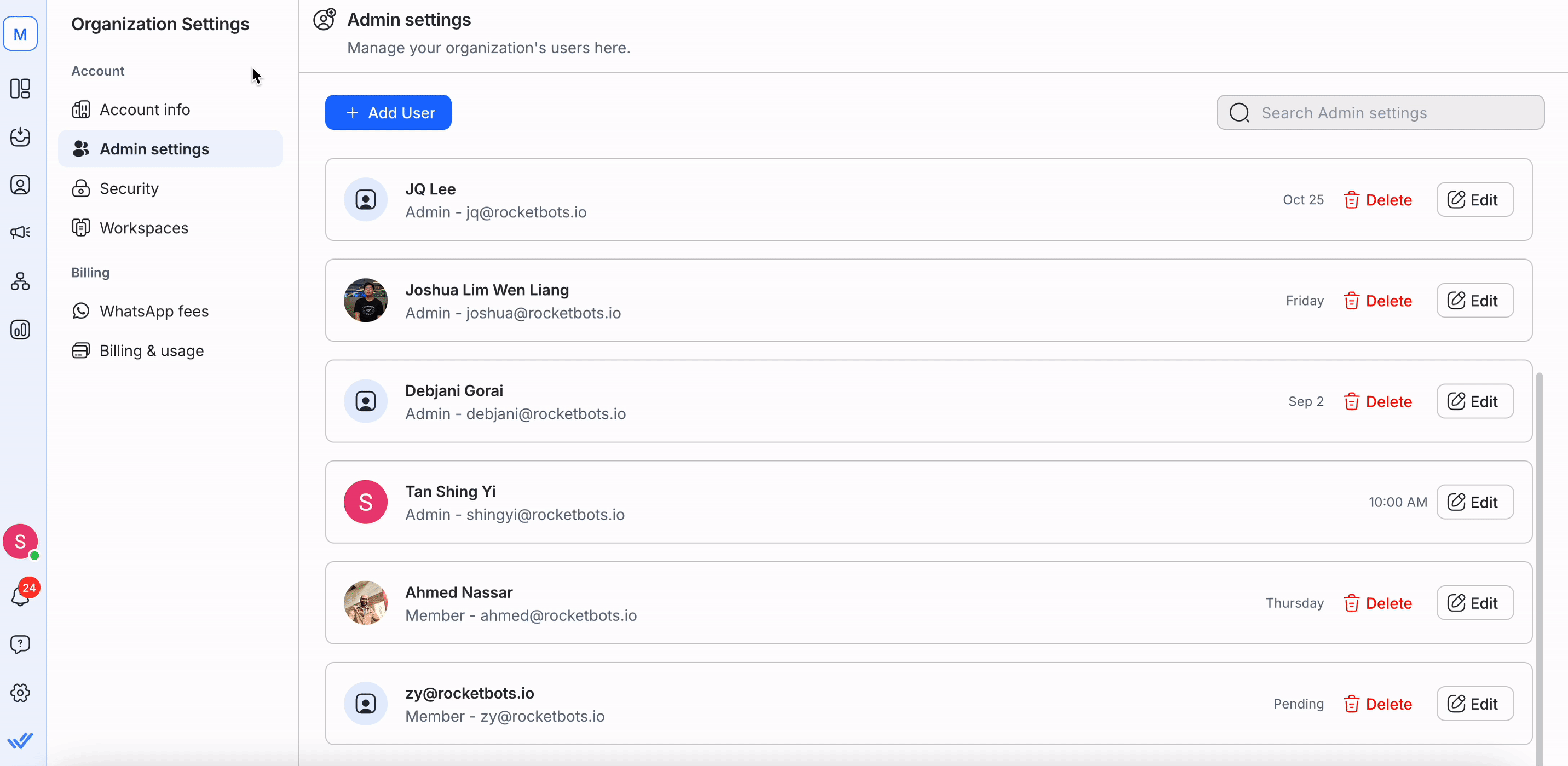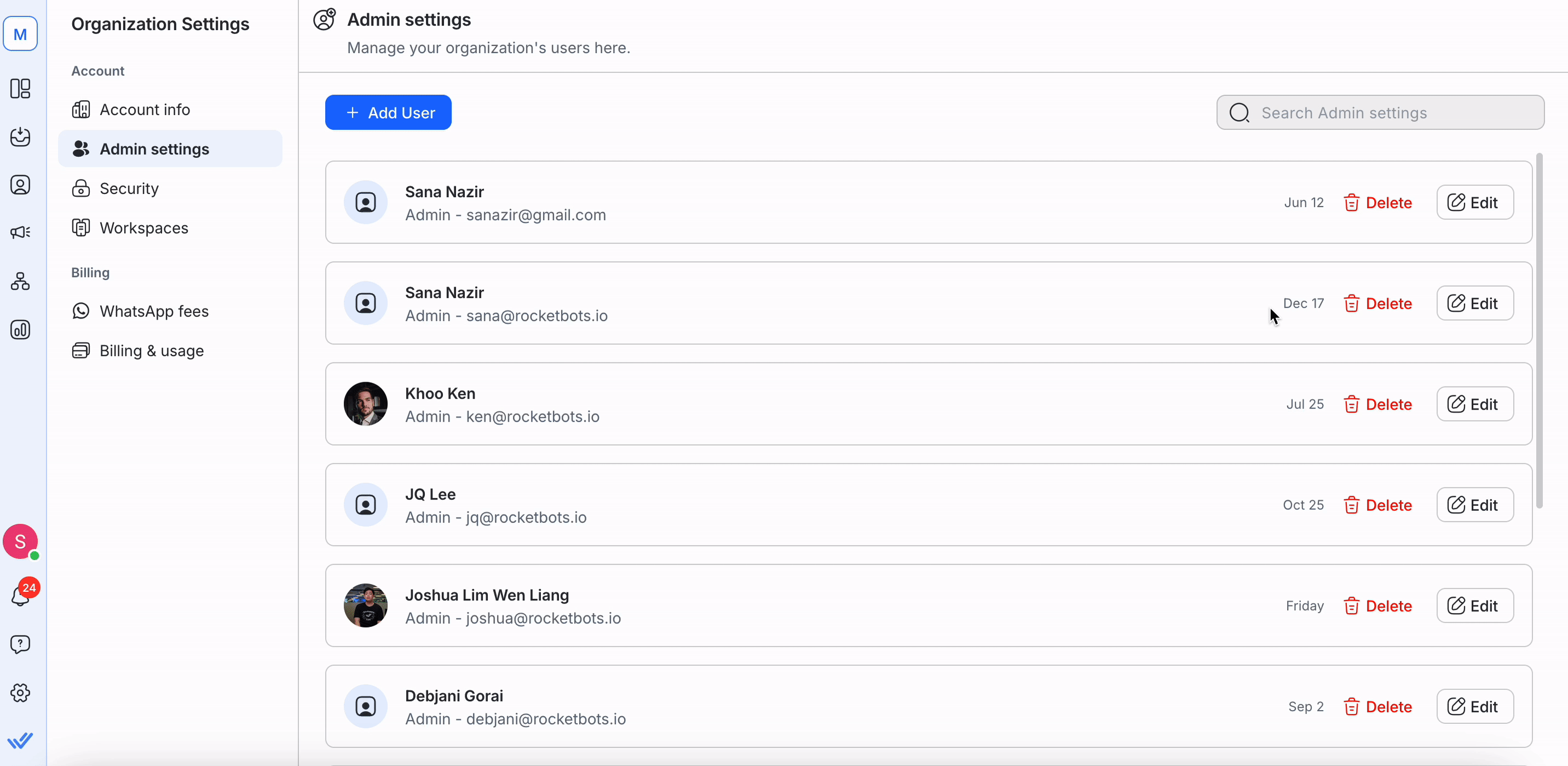Quick Start
What is respond.io?
Setting Up an Account
Connecting Channels
Inviting Your Teammates
Getting Contacts to Message You
Automated Welcome and Away Messages
Responding to Messages
Glossary of Terms
Channels
WhatsApp Business Platform (API) Quick Start
Getting Ready for Inbound Conversations
Getting Ready for Promotional Messaging
WhatsApp Official Business Account (Blue Tick)
Grow your WhatsApp Audience by Maximizing Entry Points
Get WhatsApp API Account for Government Agencies
WhatsApp Business Calling API
Meta Business Verification
WhatsApp Message Templates
WhatsApp Pricing
WhatsApp Business Platform (API) Channel Configuration
WhatsApp Messaging Limits
Meta Product Catalog
Change Your WhatsApp Business Display Name
Migrating from WhatsApp Personal or WhatsApp Business App
Phone Number Migration to respond.io WhatsApp Business Platform (API)
Turn-off WhatsApp Number Two-Step Verification
WhatsApp Cloud API
360dialog WhatsApp
Twilio WhatsApp
MessageBird WhatsApp
Vonage WhatsApp
Phone Number Migration to WhatsApp Cloud API
TikTok
Facebook Messenger
Facebook Messenger Overview
Facebook Messenger Quick Start
Facebook Chat Plugin
Facebook Private Replies
Facebook Message Tag
LINE
Viber
Telegram
Website Chat Widget
Website Chat Widget Overview
Website Chat Widget Quick Start
Install Website Chat Widget on WordPress
Install Website Chat Widget on Shopify
Install Website Chat Widget on Wix
Install Website Chat Widget on Joomla
Install Website Chat Widget on Squarespace
SMS
Custom Channel
Product
Dashboard & Reporting
Dashboard
Reports Overview
Reports: Conversations
Reports: Responses
Reports: Resolutions
Reports: Messages
Reports: Contacts
Reports: Assignments
Reports: Leaderboard
Reports: Users
Reports: Broadcasts
Inbox
Inbox Overview
Assignment and Closing a Conversation
Custom Inboxes
Interacting with Respond AI Prompts
Using AI Assist
Contacts
Broadcasts Module
Workflows
Workflows Overview
Workflow Triggers
Workflow Steps Overview
Step: AI Agent
Step: Send a Message
Step: Ask a Question
Step: Assign To
Step: Branch
Step: Update Contact Tag
Step: Update Contact Field
Step: Open Conversation
Step: Close Conversation
Step: Add Comment
Step: Jump To
Step: Date & Time
Step: Wait
Step: Trigger Another Workflow
Step: HTTP Request
Step: Add Google Sheets Row
Step: Send TikTok Lower Funnel Event
How to Avoid Workflow Loops
Step: Update Lifecycle
Step: Send Conversions API Event
Dynamic Variables
Workspace Settings
Managing a Workspace
General info (previously General)
User settings (previously Users)
Teams (previously Team Settings)
Channels
Growth Widgets
Contact Fields
Integrations
Respond AI
Closing Notes
Snippets
Tags
Files
Data Export
Contact Import
Lifecycle
Organization Settings
Organization Overview
Account info (previously General)
Admin Settings (previously Users)
Workspaces
WhatsApp Fees
Billing & Usage
Security
User Account
Mobile App
Installing respond.io Mobile App
Messaging From Your Mobile
Managing Notifications On Your Mobile
Configuring mobile app settings
Help Menu
Conversation Led Growth
Capture Leads
How to Collect Contacts’ Emails and Phone Numbers
How to Route Contacts from CTC Ads to Agents
How to Send Outbound Sales Messages
How to Track Conversation Source from Multiple Websites
How to Enrich Customer Data from a CRM or other Business Software
Convert Leads
How to Automate Product Info Sharing in Conversations Initiated via CTC Ads
How to Automatically Qualify Contacts Based on Budget Using AI Agent
Assignment Strategy: How to Automate Contact Distribution & Load Balancing
How to Maximize Customer Service Potential with AI Agent
How to Automate Contact Information Collection with AI
How to Block Contacts and Manage Spam
How to Create Automated Welcome and Away Messages
How to Create Automated Chat Menus
How to Route Contacts to Preferred AI Agent
How to Route Contacts by their Preferred Language
How to Route Contacts by Team Functions
How to Route Contacts by Shifts
Assignment Strategy: How to Unassign Agents after Conversations Closed
How to Get Contacts’ Consent for Personal Data Collection
How to Promptly Transfer Conversation Between Agents
How to Guide Customers from Exploration to Purchase with Engaging Menus
How to Optimize Customer Onboarding with Automated & Customized Welcome Messages
How to Streamline Meeting Scheduling via CTC Ads
How to Get a Complete View of the Customers
How to Simplify Customer Escalation with Automation
How to Transfer Contacts to the Next Shift Automatically
How to Optimize Agents’ Productivity in the Inbox Module
How to Write an Optimal AI Persona (Best Practices)
How to Write the Best Knowledge Sources for AI Agents
How to Align AI Conversations with Your Brand Voice
How to Draft Customer Replies with AI
How to Convert Image to Text Using AI
How to Automate Calculations Using AI
How to Automate Lifecycle Tracking in Google Sheets
Retain Customers
How to Route New and Returning Contacts
How to Route VIP Contacts
How to Send CSAT to Customer and Save Data in Google Sheets or CRMs
How to Send Outbound Support Messages
How to improve lead targeting and automatically send purchase events to Meta when a customer makes a payment
Reporting and Analytics
Broadcasts Use Cases
How to Send a Simple Broadcast
How to Start a Workflow Based on Broadcast Response
How to Import to Broadcast via WhatsApp
How to Troubleshoot a Failed Broadcast
Integrations
Dialogflow
Dialogflow Overview
Dialogflow: Connecting to Dialogflow
Dialogflow: Creating a Chatbot
Dialogflow: Managing Intents
Dialogflow: Parameters
Dialogflow: Events
Dialogflow: Response Templates
Dialogflow: Custom Payloads
Dialogflow: Fulfillment Webhook Request
Zapier
E-Commerce Integration: Shopify
E-Commerce Integration: BigCommerce
E-Commerce Integration: WooCommerce
E-Commerce Integration: Magento
CRM Integration: HubSpot
CRM Integration: Salesforce
CRM Integration: Pipedrive
CRM Integration: ActiveCampaign
Zapier
Make
Meta Business Accounts
TikTok Messaging Ads Integration
Developer API
HubSpot
Webhooks
Salesforce
Table of Contents
- Home
- Product
- Organization Settings
- Admin Settings (previously Users)
Admin Settings (previously Users)
Updated
by JQ Lee
Getting Here
This setting can be accessed from the Organization Settings navigation menu under the menu item, Admin settings.

From this setting, you can:
Organization Access
In an Organization, there are different roles that will allow for different restrictions and accessibility across organization settings.
The table below summarises the available roles and their respective accessibilities.
Organization Role | Description | General Settings | Users Settings | Spaces Settings | Billing Settings |
Admin | Organization Admins have access to all spaces and they can manage organization settings, Users and billing. | ✅ | ✅ | ✅ | ✅ |
Billing Admin | Billing Admins are allowed to manage organization billing. | ✅* | ✅* | ✅* | ✅ |
User Admin | User Admins are allowed to manage Organization Users and Workspaces. | ✅* | ✅* | ✅ | - |
Member | Organization members are allowed to access Workspaces within an Organization when given permission to do so. | - | - | - | - |
* Limited Access
Organization Admin
An Organization Admin has the most comprehensive access to the Organization as he/she can manage everything within an Organization.
As an Organization Admin, here's what you can or can't do:
✅ Access to all organization settings
✅ Manage the Organization's information
✅ Manage the Organization's billing information
✅ Manage all Organization Users
✅ Manage all Workspaces
✅ Manage the Organization's subscriptions
✅ Cancel Subscription
✅ Delete the Organization
For enhanced security, explore the settings available on our platform here.
Billing Admin
The Billing Admin can manage the billing information, make changes to the subscription, edit payment details and view invoices.
As a Billing Admin, here's what you can or can't do:
✅ Access to all organization settings
✅ View the Organization's information
✅ Manage the Organization's billing information
✅ View all Organization Users
✅ View all Workspaces
✅ Manage the Organization's subscription
❌ Cancel Subscription
❌ Delete the Organization
User Admin
User Admin can manage the Users and Workspaces within an Organization.
As a User Admin, here's what you can or can't do:
❌ Access to all organization settings
✅ View the Organization's information
✅ View the Organization's billing information
✅ Manage all Organization Users with the following limitations:
- Add Member role Users
- Delete Member role Users
- Edit assigned Workspaces of all Users
✅ Manage all Workspaces
❌ Manage the Organization's subscription
❌ Cancel Subscription
❌ Delete the Organization
Member
An organization member has no access to organization settings. Their access is only limited to the Workspaces they are granted access to.
Users Overview
Here, you will be able to see the list of existing Users in the Organization. If they have not accepted your invitation, their last active time will be shown as 'Pending' instead.

User Profile
The user profile consists of the User's profile avatar, display name, organization user role and email address.
Last sign-in
The time beside the Action button shows the User's last sign-in time on the platform. This is useful for monitoring purposes.
Actions
Actions that can be carried out here include:
Managing Organization Users
Adding an Organization User
Step 1: Navigate to Users Settings
Go to Organization Settings > Admin Settings.
Step 2: Press ADD USER
At the top bar, press the blue ADD USER button and the Add User dialog should open up.

Step 3: Fill in the email address
Enter the email address of the User that you wish to invite into the Email Address field.
Step 4: Select Organization Access
Select appropriate Organization access for this new User.
Step 5: Submit the details
Once you have filled out the fields, click the blue NEXT button on the bottom right.
An email invitation will be sent to the User's email address that you entered. The new User will have to click on a link embedded in the email invitation to gain access to the Workspace.
Step 6: Assign this User to Workspace(s)
After the User is created, you can assign this User to the Workspaces within the Organization. Add the relevant Workspaces and press ASSIGN WORKSPACE when you are ready. You can skip this step if you wish to do it later by pressing SKIP.

Editing an Organization User
Step 1: Access Admin settings
Go to Organization Settings > Admin Settings.
Step 2: Search for User
Search for the User’s name and select Edit.
Step 3: Update and save details
Make the necessary changes and select Save.
1. Billing Admins can only view Users and cannot make changes.
2. User Admins cannot promote or demote members to prevent unauthorized actions.
Deleting an Organization User
Users cannot delete themselves; another authorized User must perform this action.
Step 1: Access Admin Settings
Go to Organization Settings > Admin Settings
Step 2: Search for User
Search for the User’s name and select Delete.
User Admins can only delete Users with Member access to prevent misuse.
Step 3: Confirm deletion
Review the details and select Delete to continue.
- The User loses access to all Workspaces.
- All their assigned Contacts in Workspaces will be unassigned.

FAQ and Troubleshooting
How can I change a user’s email in my Workspace?
To change a user’s email, add a new user with the new email and provide them with the same access level as the user with the email you want to change.
Learn how to add a new user here. If an email is obsolete, you can delete the user by following the instructions here.
Feeling stuck? Do not fear.
Need assistance? Contact us for support. Help is here!This is the text block that will appear when the button is clicked.
Account info (previously General)
Workspaces
Related Articles
User settings (previously Users)
Under the User Workspace settings section, you can manage the Users that have access to your Workspace.
Teams (previously Team Settings)
Under the Team Workspace settings, you can add, delete or manage Teams belonging to the Workspace.
Account info (previously General)
Learn how to manage and edit Organization information.
